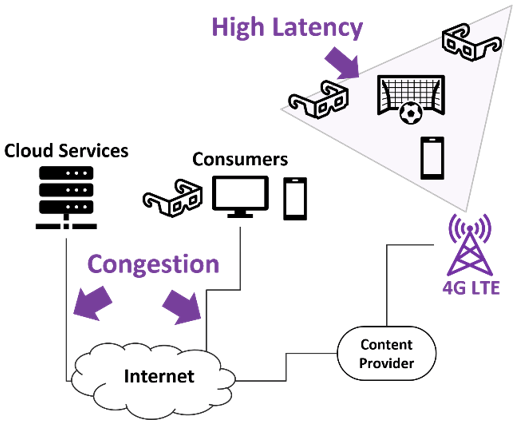
With the introduction of the 5G network, business network infrastructure and design will be reimagined. 5G will unleash tremendous computational power. Low latency, greater capacity, and faster network speeds will be a catalyst, particularly for cloud computing. The deployment of the next generation of networks will speed up business adoption of the cloud.
Contents
Let’s know about the cloud
Cloud is the technology that enables access to computing resources, data storage, development tools and applications over the web. The access to computing services over the cloud ensure speed, scalability and flexibility to innovate and develop business IT.
On the other hand cloud computing enables running processes and software over the internet. Cloud and cloud computing coexist, that is we will not be able to access data stored on the cloud in the absence of online processing which essentially is cloud computing and cloud computing also needs a location for storage.
One of the best examples is Google Drive and Google Docs where the former acts as the storage location that is the cloud while the latter performs the role of cloud computing.
The bandwidth requirement of applications varies with the workload. Over the years the cloud has solved our problem of slow network speed by allowing easy and fast transfer of large amounts of data between devices. Cloud computing enabled this while providing us with security and backup capabilities at the same time.
But with every passing day, our bandwidth requirements to utilise the potential of cloud infrastructure are growing. As per estimates, the number of internet of things (IoT) devices is set to grow to 30.9 billion by 2025. This reaffirms the fact that to manage the different cloud architectures lower latency and higher speeds are needed. A transition to the next generation of networks is crucial in supporting the large user of cloud computing.
A brief introduction to the 5G technology
5G is the fifth generation of the network. The introduction of the next generation of networks will introduce tremendous changes in cloud computing. The higher speeds will be a catalyst for mobile cloud computing services.
By 2023, it is expected that there will be 1 billion 5g subscriptions which will account for 20% of the mobile data traffic.
5g will enable virtual connectivity between everyone and everything. The virtual connectivity will ensure seamless data access from anywhere.
Mobile cloud computing combines the power of cloud computing and mobile computing with the help of a wireless network. Delivery and execution of high-quality applications over the mobile have been made possible with this technological innovation.
Both cloud and mobile computing use a wireless network to access systems. But the essential difference between these two is that cloud computing enables us to organize and store our data whereas mobile computing access information through a mobile device.
Combining the two technologies enables a seamless user experience on any device or while switching devices.
Why club cloud computing with 5G?
Often our file sharing and uploading are hindered by network congestion. The network faces issues in providing high bandwidth for performing certain tasks consistently.
The non-device storage capability offered by the cloud is a useful capability across industries ranging from smart cars, and healthcare to wearable devices. Reliability, efficiency and faster access are promises delivered by cloud-based products and services. 5G will boost the integration of these technologies in enterprises as the 5g network will deliver zero to ultra-low latency enabling smoother communications.
Mobile cloud computing allows the usage of fewer device resources because of cloud support. The shared resources of mobile applications facilitate quicker development and provide reliability with data being backed up on the cloud.
Our need for speed and flexibility has accelerated the demand for mobile cloud computing services. We require the capabilities of mobile cloud computing in social media, email, finance and commerce, healthcare etc.
What will be the impact of 5g on cloud computing?
Clubbing the two technologies will open for us a whole new world full of innovations and opportunities. Let us look at the impacts that we would see:
- Increased accessibility- 5g network will help in eliminating the bandwidth gap across regions which will make cloud computing services available in remote regions as well.
- IoT connectivity- The low latency and high-speed network will allow easier access to the cloud for IoT systems and devices. This connectivity will allow greater automation and digitisation of business processes.
- Better connectivity for work from anywhere (WFX)- Significant improvements in remote working experiences can be made possible by combining the potential of the 5g network and cloud computing. Zero technical difficulties and delays will enable organisations to work without an office.
- Improved security systems- The downside of technological advancements is the increase in the number of hacking incidents. 5g connectivity enhances the security capabilities by boosting the ability to identify attacks and make environments like hybrid cloud much safer.
- Enables edge computing- Linking 5g network with cloud computing opens up opportunities for edge computing. Edge computing helps in enhancing remote system performance by using lesser bandwidth.
- Reach customers easily- Machine-to-machine communication becomes much easier with the cloud and high speeds of the 5g network. This will make communications more reliable and allow organisations to reach customers faster.
How is cloud connectivity implemented with 5g?
Cloud connectivity with 5g has the ability to deliver economies of scale. But with all the possibilities there is an increase in complexity as well.
Continuous software updates are going to shape cloud connectivity in the 5g era. The updates will include both network and application releases. The frequency of updates will have to be in line with the supply chain in order to prevent interoperability glitches.
The continuous integration/continuous deployment model will need to have key inputs from testing, validation and assurance.
Cloud requires further development to support 5g. It is because of the growing importance of edge, mobile edge and fog computing in the domain of cloud computing. 5g technologies are also undergoing cloudification through network softwarisation.
The developments in both technologies are dependent on each other for a seamless experience.
What will be the challenges of cloud and connectivity in the 5g era?
The increased potential of the network with 5g technology has security implications as well because of the changes in network architecture and new technology adoption.
There will be a manifold increase in the number of devices connected with 5g. The increased number of users and the high bandwidth will unlock new doors for hackers. This is where we have to protect data on the cloud. The volume of data on the cloud makes it even more important to consider the security aspects. Also, distributed edge clouds are more prone to eavesdropping and other attacks from the public internet.
Security of the network will be a critical challenge in the 5g plus cloud era. Security provisions need to be an integral part of the roadmap.
Conclusion
Every generation of networks has opened doors for new innovations. The 5g network will significantly expand the business potential of cloud computing. Cloud computing has played a pivotal role in the digital transformation of enterprises. 5g will power the cloud and allow businesses to be more responsive and meet real-time business needs. Customising the existing cloud architecture will decide whether we will be able to unleash the potential of the new technology. Cloud environment powered by 5g technology will transform the way organisations do business.
FAQs
Will 5g replace the cloud?
Cloud services will improve in terms of reliability, speed, and efficiency with the introduction of 5g. As technological innovations are becoming increasingly dependent on the cloud, 5g will help in their integration with enterprise infrastructure. 5g will enable network cloudification which will allow network service providers to provide cloud services.
How have cloud and 5g helped in making extended reality accessible?
Together cloud and 5g technology have made extended reality (XR) accessible to a wider audience. XR requires large amounts of data to be downloaded on devices from multiple cloud sources. The sources can be distributed over multiple locations and high speed is required to ensure a seamless experience.
What is 5g architecture?
5G is made up of a large number of advanced technologies supporting a wide variety of applications. The intelligent architecture utilised by the 5g network consists of a RAN that is no longer constrained by base station proximity. Major components of 5g architecture are:
- User plane function
- Data network
- Authentication server function
- Core access and mobility management function
- Network slice selection function
- Policy control function
- Application function
- Unified data management
- Network exposure function
Are cloud computing and 5g compatible?
The relationship between the two technologies is such that one is dependent on the other. 5g will ensure that cloud service providers are able to reach enterprises faster and reliably. The two technologies working together will help deliver cloud applications to their full potential.
Does 5g work with edge computing?
5g will increase the ability of organizations to analyse more data. The increased data transfer speeds will unlock more use cases of edge computing. Without the capability of edge computing, of processing data closer to the user, 5g will not be able to deliver to the expectations of lower latency. Edge computing complements 5g by allowing it to carry large volumes of data with reliability, speed and efficiency.
What is mobile cloud computing?
The capabilities of mobile computing and cloud computing are combined in mobile cloud computing(MCC). Combining the two technologies ensures a smooth user experience across all devices or when switching between devices. The technology makes it possible to execute a wide variety of applications over a range of devices. MCC utilises the IT infrastructure to deliver extended battery life, improved data storage and processing power, increases reliability and scalability and easier integration.

















